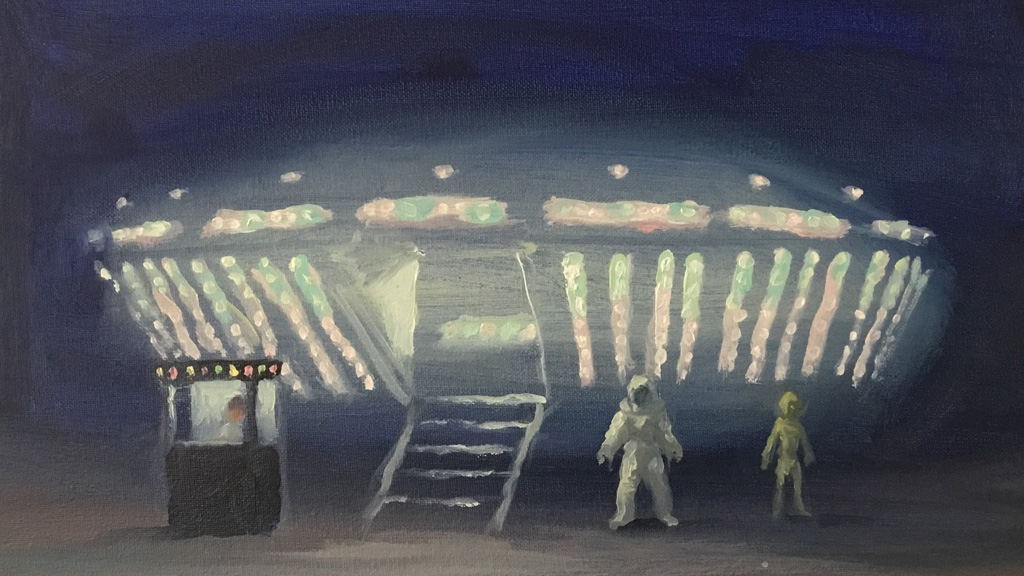Since Spiegelworld began, Australian artist Mark Ogge has been there to commemorate our most important occasions. This tradition started in 2006 with a mural commissioned for the grand entrance archway at Spiegelworld’s first site at the South Street Seaport in New York City. Guests would pass the stinking dumpsters and decaying remains of the Fulton Fish Market. Up ahead, a colorful archway featuring images of a glorious underwater circus would lead them to Spiegelworld’s wonderland on Pier 17, where Absinthe was performed in a century-old spiegeltent.

Mark Ogge and Spiegelworld’s Impresario Extraordinaire Ross Mollison first met as neighbors in the seaside suburb of St Kilda in Melbourne, Australia. Both shared a love of circuses and fun parks. At St Kilda’s Luna Park, Mark was commissioned to paint a mural for the refurbished Scenic Railway, the world’s oldest operating wooden roller coaster. There, he created a 60-square-meter painting depicting scenes from 1,001 Nights along the length of the coaster’s platform. In 2001, he also painted the elaborate façade of David Bates’ The Famous Spiegeltent, which toured arts festivals from Edinburgh to Melbourne.
Recognizing a common sensibility and passion, Ross began commissioning Mark to create a new painting every time Spiegelworld opened a new show. Working in oil with rich colors and deep symbolism, Mark was given complete freedom to represent his own interpretation of the show’s themes and characters. There have also been special projects including the stunning Circus Automaton, a handmade, coin-operated mechanical toy theatre which now resides inside the Atomic Saloon at The Venetian Las Vegas.
Mark’s work has been described as a dichotomy between enchantment and disillusionment. Usually drawing from life, he has always been inspired by the falling-down amusement park, the circus big top and the traveling fun fair. He recently spent two months living in Ross’s Brooklyn apartment so that he could complete a series of paintings of Coney Island.

“My work aims to recapture the sense of wonder that a child can experience, but also the ordinariness behind it,” Mark says. “Take the painting of the Gravitron that I painted during my time in Berlin: the Gravitron is an actual fairground ride in Australia. On one level, for a child, the Gravitron is a wondrous apparition, full of the excitement and mystery: space travel, aliens, the promise of some extraordinary experience once we walk up the ramp and enter. But we also know that the ride cannot fulfill this. The bored woman in the ticket box hints at this underlying ‘ordinariness’. Yet to a child the ticket booth is a glowing portal to a transcendent experience.”
Mark’s painting of The Gravitron was purchased by Spiegelworld in 2018 and is currently on display in the Reliquary at the OPIUM Theatre in Las Vegas.
Mark continues, “As children we are gripped by wonder, everything is magical. Then as adults we shift to a more ‘knowing’ perception, seeing the shabbiness, crassness and monotony. But we are still capable of experiencing intense engagement and wonder, and often shift between the two.”
In 2019, Ross and his friend Mary Stuart from Luna Park assisted Mark in securing a magnificent, deconsecrated church in the historic former goldmining village of Clunes, about an hour’s drive from Melbourne. Mark has since converted the church into his home and studio. It’s there that he completed his most recent contribution to the collection. Commemorating the opening of Atomic Saloon Show in Las Vegas, where it now hangs, the painting depicts a host of characters partying in the saloon, including cowboys and showgirls, an alien, a penguin, a nun and a Jesus-like David Mancuso in the DJ booth.
“For me the characters of sideshows, circus and Commedia dell’arte are avatars for ourselves,” Mark says. “We all have a bit of ‘The Strong Man’, ‘The Half-Man Half-Woman’, ‘The Diva’, ‘Pierrot’, ‘Magician’ or ‘The Show Girl’ in us. It’s why the Commedia dell’arte was so successful: they would go from town-to-town playing the same characters. And in every town the audience would recognize local personalities or aspects of themselves. They’re timeless and universal.”